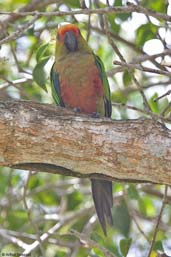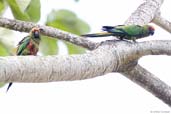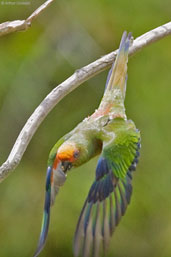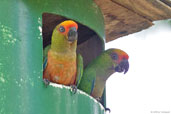Brazilian name :Jandaia-de-testa-vermelha

November 2008
The Golden-capped Parakeet is endemic to
central south-eastern Brazil from Bahia and Goiás south to
Paraná. It is normally found on the edge of the forest
and, when it is in more open country, there is usually a patch of
forest nearby.
Habitat destruction and collecting for the caged bird trade have
reduced this species from being quite common to being classified
as Near Threatened by Birdlife International.
In the past it has been considered a subspecies of Sun Parakeet
A. solstitialis along with Jandaya Parakeet
A. jandaya but all three are now considered to be
separate species

These photos are of the nominate
sub-species found in the north of its range and, indeed,
Camaçari is close to the northern limit of its range. The
southern sub-species A. a. aurifrons is much greener on
the breast and upper belly.
It feeds on fruit and seeds as well as crops such as
maize.

They have been very successful and the 5 pairs found by Pedro initially had by 2008 increased to 300 individuals in the area. The artificial nests are used by other birds as well including Ferruginous Pygmy-owl, Tropical Screech-owl and American Kestrel
There are recordings on xeno-canto, a distribution map from NatureServe and additional information available via Avibase. There is also a page on Wikiaves.

| Previous Page | Back to Index | Next Page |